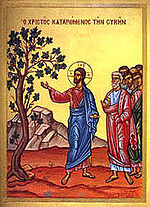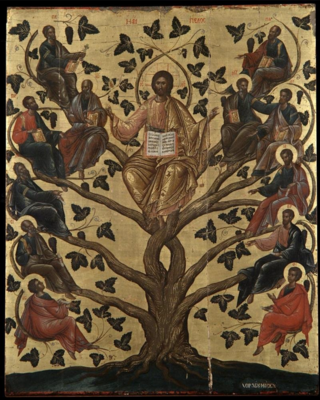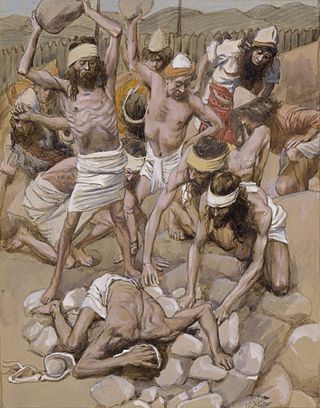
Figs in the Bible include references to both the tree and its fruit in the Tanakh and the New Testament, which are sometimes symbolic.

Figs in the Bible include references to both the tree and its fruit in the Tanakh and the New Testament, which are sometimes symbolic.
The fig tree is the third tree to be mentioned by name in the Hebrew Bible. The first is the Tree of life and the second is the Tree of the knowledge of good and evil. Adam and Eve used the leaves of the fig tree to sew garments for themselves after they ate the "fruit of the Tree of knowledge" (Genesis 2:16–17), when they realized that they were naked (Genesis 3:7).
In Deuteronomy, the Promised Land is described as "a land of wheat and barley, of vines and fig trees and pomegranates, a land of olive oil and honey; a land where you will eat food without scarcity, in which you will not lack anything;" (Deuteronomy 8:8–10). During Solomon's reign Judah and Israel, from Dan to Beersheba, lived in safety, each man "under his own vine and fig tree" (1 Kings 4:25), an indicator of national wealth and prosperity. 2 Kings 18 states that Hezekiah rebelled against the King of Assyria, of whom he had become a vassal. In response, the Assyrian commander attempted to sway the army of Jerusalem by offering deserters each his own vine and fig tree.
Proverbs 27:18 likens tending a fig tree to looking after one's master. There was a fig tree in the garden of the Song of Solomon, and in the year of love the tree formed its fruit early (Song 2:13).
The fig tree and figs are featured in the Book of Jeremiah and mentioned briefly in the Book of Micah. [1]
Another species of ficus, the Egyptian sycamore fig is occasionally mentioned as well, for example 1 Kings 10:27.

The parable of the budding fig tree is found in Matt 24:32–36, Mark 13:28–32, Luke 21:29–33 as part of the Olivet discourse. The fig tree could be understood as symbolic of Israel Joel 2:21–25.
The parable of the barren fig tree is a parable of Jesus recorded in the Gospel of Luke 13:6–9. A vinekeeper holds out hope that a barren fig tree will bear fruit next year.
Mark 11:12–20 includes an account of Jesus cursing the fig tree:
The next day as they were leaving Bethany, Jesus was hungry. Seeing in the distance a fig tree in leaf, he went to find out if it had any fruit. When he reached it, he found nothing but leaves, because it was not the season for figs.
Then he said to the tree, "May no one ever eat fruit from you again." And his disciples heard him say it. On reaching Jerusalem, Jesus entered the temple area and began driving out those who were buying and selling there. He overturned the tables of the money changers and the benches of those selling doves, and would not allow anyone to carry merchandise through the temple courts. And as he taught them, he said, "Is it not written: " 'My house will be called a house of prayer for all nations'? But you have made it 'a den of robbers.'" The chief priests and the teachers of the law heard this and began looking for a way to kill him, for they feared him, because the whole crowd was amazed at his teaching. When evening came, they went out of the city.
In the morning, as they went along, they saw the fig tree withered from the roots. Peter remembered and said to Jesus, "Rabbi, look! The fig tree you cursed has withered!" "Have faith in God," Jesus answered. "Truly I tell you, if anyone says to this mountain, 'Go, throw yourself into the sea,' and does not doubt in their heart but believes that what they say will happen, it will be done for them. Therefore I tell you, whatever you ask for in prayer, believe that you have received it, and it will be yours. And when you stand praying, if you hold anything against anyone, forgive them, so that your Father in heaven may forgive you your sins."
— NRSV
A parallel is found in Matthew 21:18–22, but the fig tree withers immediately and is noticed at that time by the disciples.
When the apostle Nathanael first encounters Jesus and asks how Jesus knows him, the answer is that He has already seen Nathanael sitting under the fig tree (John 1:47–51).

Mark 11 is the eleventh chapter of the Gospel of Mark in the New Testament of the Christian Bible, beginning Jesus' final "hectic" week, before his death as he arrives in Jerusalem for the coming Passover. It contains the stories of Jesus' entry into Jerusalem, his cursing of the fig tree, his conflict with the Temple money changers, and his argument with the chief priests and elders about his authority. Biblical commentator Christopher Tuckett notes that "the Passion narrative in Mark is usually adjudged to start at chapter 14, but there is a real sense in which it can be said to start ... at the start of chapter 11".

John 15 is the fifteenth chapter in the Gospel of John in the New Testament section of the Christian Bible. It is part of what New Testament scholars have called the 'farewell discourse' of Jesus. It has historically been a source of Christian teaching and Christological debate and reflection, and its images have been influential in Christian art and iconography. The chapter implies one of the highest and most developed Christologies to be found in the New Testament. The original text was written in Koine Greek. The book containing this chapter is anonymous, but early Christian tradition uniformly affirmed that John composed this Gospel.

Luke 10 is the tenth chapter of the Gospel of Luke in the New Testament of the Christian Bible. It records the sending of seventy disciples by Jesus, the famous parable about the Good Samaritan, and his visit to the house of Mary and Martha. This Gospel's author, who also wrote the Acts of the Apostles, is not named but is uniformly identified by early Christian tradition as Luke the Evangelist.

The True Vine is an allegory or parable given by Jesus in the New Testament. Found in John 15:1–17, it describes Jesus' disciples as branches of himself, who is described as the "true vine", and God the Father the "husbandman".

Mark 13 is the thirteenth chapter of the Gospel of Mark in the New Testament of the Christian Bible. It contains Jesus' predictions of the destruction of the Temple in Jerusalem and disaster for Judea, as well as Mark's version of Jesus' eschatological discourse. Theologian William Barclay described this chapter as "one of the most Jewish chapters in the Bible" and "one of the most difficult chapters in the New Testament for a modern reader to understand".

Matthew 12 is the twelfth chapter in the Gospel of Matthew in the New Testament section of the Christian Bible. It continues the narrative about Jesus' ministry in Galilee and introduces controversy over the observance of the Sabbath for the first time.

Luke 8 is the eighth chapter of the Gospel of Luke in the New Testament of the Christian Bible. The book containing this chapter is anonymous but early Christian tradition uniformly affirmed that Luke the Evangelist, a companion of Paul the Apostle on his missionary journeys, composed both this Gospel and the Acts of the Apostles. This chapter mentions the women who supported Jesus and records some of the great miracles he performed, as well as several parables told by him.

Luke 13 is the thirteenth chapter of the Gospel of Luke in the New Testament of the Christian Bible. It records several parables and teachings told by Jesus Christ and his lamentation over the city of Jerusalem. Jesus resumes the journey to Jerusalem which he had embarked upon in Luke 9:51. This chapter, taken with Luke 12:54-59, begins to outline and illustrate "the problem with the Jewish nation" which accounts for the urgency of his journey to Jerusalem. The book containing this chapter is anonymous, however early Christian tradition generally accepts that Luke the Evangelist composed this Gospel as well as the Acts of the Apostles.

Luke 17 is the seventeenth chapter of the Gospel of Luke in the New Testament of the Christian Bible. It records "some sayings of Jesus" and the healing of ten lepers. The book containing this chapter is anonymous, but early Christian tradition uniformly affirmed that Luke the Evangelist composed this Gospel as well as the Acts of the Apostles.

Luke 21 is the twenty-first chapter of the Gospel of Luke in the New Testament of the Christian Bible. It records the observations and predictions of Jesus Christ delivered in the temple in Jerusalem, and his exhortation "to be watchful". The book containing this chapter is anonymous, but early Christian tradition uniformly affirmed that Luke the Evangelist composed this Gospel as well as the Acts of the Apostles.

The parable of the barren fig tree is a parable of Jesus which appears in Luke 13:6–9. It is about a fig tree which does not produce fruit.

Alcoholic beverages appear in the Hebrew Bible, after Noah planted a vineyard and became inebriated. In the New Testament, Jesus miraculously made copious amounts of wine at the wedding at Cana. Wine is the most common alcoholic beverage mentioned in biblical literature, where it is a source of symbolism, and was an important part of daily life in biblical times. Additionally, the inhabitants of ancient Israel drank beer and wines made from fruits other than grapes, and references to these appear in scripture. However, the alcohol content of ancient alcoholic beverages was significantly lower than modern alcoholic beverages. The low alcohol content was due to the limitations of fermentation and the nonexistence of distillation methods in the ancient world. Rabbinic teachers wrote acceptance criteria on consumability of ancient alcoholic beverages after significant dilution with water, and prohibited undiluted wine.
The Quran contains references to more than fifty people and events also found in the Bible. While the stories told in each book are generally comparable, there are also some notable differences.

The Parable of the Budding Fig Tree is a parable told by Jesus in the New Testament, found in Matthew 24:32–35, Mark 13:28–31, and Luke 21:29–33. This parable, about the Kingdom of God, involves a fig tree, as does the equally brief parable of the barren fig tree.
This is a glossary of terms used in Christianity.

The cursing of the fig tree is an incident reported in the Synoptic Gospels, presented in the Gospel of Mark and Gospel of Matthew as a miracle in connection with the entry of Jesus into Jerusalem, and in the Gospel of Luke as a parable. The image is taken from the Old Testament symbol of the fig tree representing Israel, and the cursing of the fig tree in Mark and Matthew and the parallel story in Luke are thus symbolically directed against the Jews, who have not accepted Jesus as Messiah. The Gospel of John omits the incident entirely and shifts the event with which it is connected, the cleansing of the temple, from the end of Jesus' career to the beginning.
Arguments that prophecies of Muhammad exist in the Bible have formed part of Islamic tradition since at least the mid-8th century, when the first extant arguments for the presence of predictions of Muhammad in the Bible were made by Ibn Ishaq in his Book of Military Expeditions. A number of Christians throughout history, such as John of Damascus and John Calvin, have interpreted Muhammad as being the Antichrist of the New Testament.
Nathanael, also known as Nathaniel of Cana was a disciple of Jesus, mentioned only in chapters 1 and 21 of the Gospel of John.

Capital punishment in the Bible refers to instances in the Bible where death is called for as a punishment and also instances where it is proscribed or prohibited. A case against capital punishment can be made from John 8, where Jesus speaks words that can be construed as condemning the practice. There are however many more Bible verses that command and condone capital punishment, and examples of it being carried out. Sins that were punishable by death include homicide, striking one's parents, kidnapping, cursing one's parents, witchcraft and divination, bestiality, worshiping other gods, violating the Sabbath, child sacrifice, adultery, incest, and male homosexual intercourse.

John 1:48 is a verse in the first chapter of the Gospel of John in the New Testament.